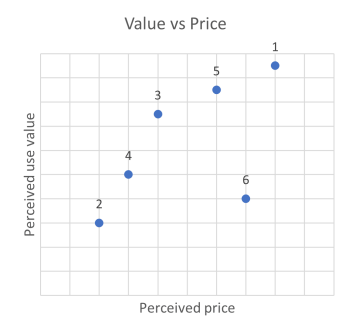The basic requirement for selling


Do you know the basic requirement for selling? Do the people in your sales team know? Do the people in your marketing team know?
It's so basic that sometimes we forget: the value to the client must be greater than the price the client pays.
Consider the diagram below, in which each point represents the positioning of a competitor in a sales opportunity:

Who will win?
It may seem obvious. However...
- If the client's decision criterion is the highest value, competitor 1 will win.
- If the decision criterion is the lowest price, competitor 2 will win.
- If the decision criterion is the best ratio between value and price, competitor 3 will win.
- If the decision criterion is the highest value with a maximum price between the price of competitors 3 and 4, competitor 4 will win.
- If the decision criterion is the lowest price with a minimum value between the value of competitors 3 and 5, competitor 5 will win.
- No decision criterion will lead to competitor 6 winning, because the price is higher than the value, i.e. the client won't buy because there is no value surplus.
In summary, the client's decision criterion determines who wins.
This highlights the importance of marketing and sales.
Marketing defines the positioning of the offer (product or service) in terms of both value and price. To do this, as well as taking part in the design and development of the offer, marketing writes the content of the communication that will embody this positioning. Based on this communication, clients perceive the use value and the price associated with the offer, deciding to buy according to their needs and preferences.
In the case of unassisted purchases in physical or virtual stores, there is no direct intervention from sales teams, so responsibility for results lies with the marketing team. However, it’s different in other cases, where the sales team plays a decisive role, both in divulging the offer and in understanding the client's needs and preferences. In fact, by understanding the client's context, the salesperson can adapt the offer and influence the purchasing decision criteria.
One possible critic of the analysis based on the diagram above is that in real life it doesn’t function that way, because the client can't quantify the perceived use value. It is true that in many cases it is not possible to quantify, but it is also true that in all cases it is possible to rank, which is a valid substitute for quantification.
Another possible critic of the analysis based on the diagram above is that the price perceived by the client is the purchase price, which is not subjective. It is true that in many cases it is the purchase price that counts (which does not invalidate the analysis), but it is also true that in other cases the cost of use, the exit cost, the total cost of ownership or other costs may be relevant to the purchase decision.
Two stories
In 2020, when I was doing strategic consulting work for an architecture firm, one of the partners asked me to help him win a tender for a multinational. He had just made a presentation to the multinational's procurement team, but felt he hadn't been persuasive enough. I asked to see the presentation and noticed that it included the design guidelines, the work methodology, the execution schedule, the work team and references from previous projects. It was almost entirely focused on supply and very little on demand, i.e. satisfying the client's needs and preferences. So I asked him a question: why should the multinational choose your proposal? He replied that it was because it had excellent design quality, a very competent team, compliance with deadlines and probably the best value for money. I then asked if the client valued all this and with what priorities. He replied that he wasn't sure.
In 2022, I worked on strategy and commercial planning for a Portuguese FMCG company. One of the company's challenges was to assert its fruit juice brand in the face of fierce competition from other manufacturers' brands and retailers' own brands. The brand's communication focused on the composition of the 100% natural juice and its durability due to an innovative manufacturing process. I asked the CEO if that was what consumers valued. He replied that he didn't know.
These stories demonstrate an excessively supply-focused vision, which is all too common in Portuguese companies. There is a lack of consideration for demand, in other words, value for the client.
Perceived use value
It is difficult to determine what value is for the client, for various reasons, such as the diversity of clients and the difficulty of dialoguing with clients. It's difficult, but not impossible. There are several ways of doing this, such as focus group studies and collecting opinions in stores, on websites, on social networks and on client service hotlines.
Sometimes the difficulty is identifying what is valued by the client. The right question to ask is "what are the client's decision criteria?". When this question is asked, various answers emerge, which always fit into at least one of three areas: functional, emotional and economic.
- On the functional side, a person can attribute value to: well-being, rest, joy, pleasure, convenience, speed, reliability, versatility, efficiency, meeting deadlines, quality of service, beauty, competence, strength, security, stability, etc. If the person represents a company, besides looking for the most appropriate solution to the company, they may also value: performing their job better, providing better client service, retaining their job, getting a promotion, etc.
- On the emotional side, a person may attribute value to: a sense of belonging to a group, recognition, fame, vanity, affirmation, power, self-esteem, self-confidence, status, influence, pioneering spirit, freedom, autonomy, independence, credibility, etc. If the person represents a company, they may also value: being seen as a problem solver, being seen as a leader, doing a favor, avoiding loss of credibility, avoiding to confront the boss, being an agent of change, etc.
- On the economic side, a person may attribute value to: a lower price, a bargain, a discount, an offer, an investment, savings, quality/price ratio, ease of payment, etc. If the person represents a company, they may also value: return on investment, more sales, lower costs, more efficiency, more productivity, more profitability, lower cost of ownership, etc.
Once you've identified the different responses, you need to understand which ones have the greatest impact on each client segment, because communication can't be scattered across different messages. Only then will the marketing teams be effective in their communication and only then will the sales teams be able to shape the offer according to the client's needs and preferences.
Perceived price
In most cases, the price perceived by the client is the purchase price. But there are several situations in which this is not the case.
One example is when comparing two packages at a retailer, the price perceived by the client may be per unit and not per package if the quantities of each package are different.
Another example is the purchase of a printer, the price perceived by the client may be based on an estimate of the cost resulting from the consumption of toner and not on the price of the printer.
Each product or service offering has its own specificity, and it is up to the marketing and sales teams to emphasize the most favorable features of their pricing strategy that best align with the client's perspectives.
Conclusion
To be effective in sales, having a good product and service offering is not enough, it is essential to always bear in mind the use value and the price perceived by the client.
Now that you have remembered the basic requirement for selling, incorporate it into your daily marketing and sales practice. It's guaranteed that it will boost your company's growth.
Filipe Simões de Almeida
Managing Partner, Fi Consulting
Published on 15-Jan-2024
